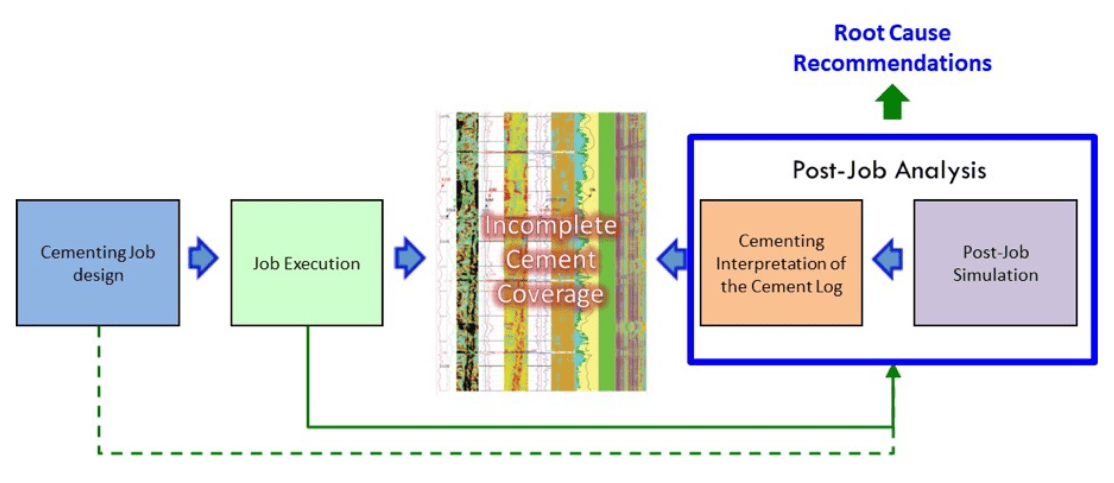Cement Jobs
9 5/8” Liner, 7” Liner and 7” Liner Top Squeeze
Background
A significant primary cementing operation was performed that involved 9 5/8” and 7” liners. The operation encountered challenges, prompting an exhaustive post-job analysis to assess the job design, conditions, and execution.
Objectives
The primary objectives of the analysis were to gather comprehensive information on the cementing operation, playback the job design against actual data, conduct post-job simulation and analysis, and identify root causes and contributing factors.
Work Methodology
The post-job analysis aimed to elucidate the job outcome by considering job design, conditions, and execution. The well was practically in gauge, with caliper runs indicating intervals under gauge at the bottom. The methodology involved washing down, pre-job circulation, pressure analysis, simulation of fluids intermixing, and cement evaluation.

Post-job analysis seeks to explain the job outcome by understanding the contribution of job design, job conditions and job execution
Job Facts
The operation involved washing down from the previous casing shoe to a specified depth, encountering tight intervals. Attempts to reestablish circulation led to a “pack-off-like mechanism,” causing leaks. Different injection rates were assessed before cementing. Pressure analysis revealed losses, and simulation indicated no fluids above a certain depth.
Analysis
Difficulties in running casing, under-gauge hole indications, and lower amplitude in cement logs suggested conditions for a hole pack-off. Injection rates, estimated Equivalent Mud Weight (EMW), and issues with mud properties and rheology were identified during the analysis.
Root Causes
The root causes included the inability to circulate casing, pack-off-like mechanisms, and issues with injection rates, spacer rheology, and cement job design. Lack of pre-job recommendations, incomplete engineering records, and insufficient laboratory details were also contributing factors.
Assessment
Areas of attention included the absence of a cement program, inadequate traceability of engineering work, and a lack of records for design criteria and pre-job activities. The cementing contractor’s technical capabilities were below expectations, underscoring the need for a basis of design to ensure well objectives.
Recommendation
It is recommended that the operator provides a comprehensive basis of design or cementing requirements to enhance technical work estimation. Additionally, improvements in record-keeping, pre-job recommendations, and laboratory reports are crucial for the success of cementing operations.
Conclusions
Primary Cementing Challenge: In the face of a critical challenge during the primary cementing operation, the inability to circulate the 9 5/8” casing at section TD proved to be a significant hurdle. This issue, in turn, hindered the seamless completion of the primary cementing process. As an immediate response, a strategic decision was made to implement a squeeze operation as a resolution to address the circulation challenges encountered.
Operational Response and Concerns: In response to the challenges faced, a thorough examination revealed the absence of confirmation regarding the presence of cement on the log. Noteworthy high amplitude readings were observed during this verification process. Additionally, an evaluation of the Equivalent Mud Weight (EMW) variation indicated a range from 1.76 – 2.48 sg, prominently noted during the pumping and displacement of cement. Further complexities emerged during the cementing of the 7” liner, where the plugging of float equipment or bottom plug resulted in the retention of all cement within the pipe. Root cause analysis pointed towards the intermixing of unclean or lost circulation material (LCM)-loaded mud with the spacer, ultimately failing to meet fluids’ hierarchy below the bottom plug. Evaluating the overall technical capabilities of the cementing contractor highlighted concerns, with an assessment falling below expectations for handling complex operations. Addressing these concerns, it is recommended that the operator provides a Basis of Design or specific cementing requirements to ensure the successful delivery of well objectives.

Work completed by: Lenin Diaz
Cement Jobs Case Study
Well Cementing and Fluids Specialist
Lenin Diaz
Do you think that Lenin has something to offer for your project? Perhaps you have something to offer Lenin?
If so, then fill in this webform and Lenin will be in touch with you as soon as possible. In the message box, please indicate the reason for the enquiry in simple and precise terms.
Privacy notice: Rest assured that only Lenin Diaz, and up to three integral personnel at drillers.com will see your contact details. We won’t distribute these details or add you to any mailing list without your explicit additional consent.





